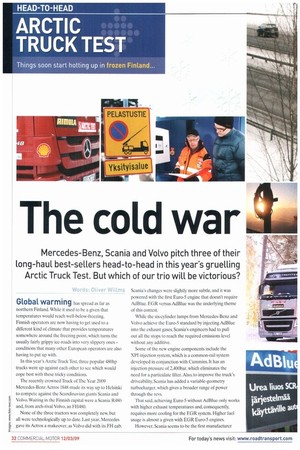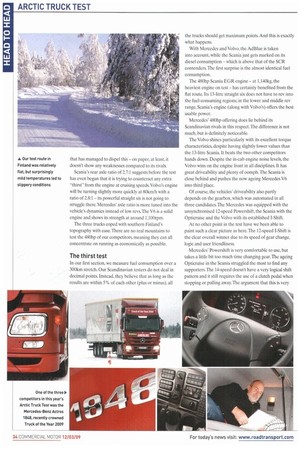The cold war
Page 32

Page 34

Page 37

Page 38

If you've noticed an error in this article please click here to report it so we can fix it.
Mercedes-Benz, Scania and Volvo pitch three of their Long-haul best-sellers head-to-head in this year's gruelling Arctic Truck Test. But which of our trio wilt be victorious?
Words: Oliver Willms Global warming has spread as far as northern Finland. While it used to be a given that temperatures would reach well-below-freezing. Finnish operators are now having to get used to a different kind of climate that provides temperatures somewhere around the freezing point, which turns the usually fairly grippy ice-roads into very slippery ones — conditions that many other European operators are also having to put up with.
In this year's Arctic Truck Test, three popular 480hp trucks went up against each other to see which would cope best with these tricky conditions.
The recently crowned Truck of The Year 2009 Mercedes-Benz Actros 1848 made its way up to Helsinki E to compete against the Scandinavian giants Scania and 8 Volvo. Waiting in the Finnish capital were a Scania R480 and, from arch-rival Volvo, an FI-1480.
None of the three tractors was completely new, but all were technologically up to date. Last year, Mercedes E gave its Actros a makeover, as Volvo did with its FH cab. Scania's changes were slightly more subtle, and it was powered with the first Euro-5 engine that doesn't require AdBlue. EGR versus AdBlue was the underlying theme of this contest.
While the six-cylinder lumps from Mercedes-Benz and Volvo achieve the Euro-5 standard by injecting AdBlue into the exhaust gases, Scania's engineers had to pull out all the stops to reach the required emissions level without any additive.
Some of the new engine components include the XPI injection system, which is a common-rail system developed in conjunction with Cummins. It has an injection pressure of 2,400bar, which eliminates the need for a particulate filter. Also, to improve the truck's driveability, Scania has added a variable-geometry turbocharger, which gives a broader range of power through the revs.
That said, achieving Euro-5 without AdBlue only works with higher exhaust temperatures and, consequently, requires more cooling for the EGR system. Higher fuel usage is almost a given with EGR Euro-5 engines.
However, Scania seems to be the first manufacturer that has managed to dispel this— on paper, at least, it doesn't show any weaknesses compared to its rivals.
Scania's rear axle ratio of 2.7:1 suggests before the test has even begun that it is trying to counteract any extra "thirst" from the engine at cruising speeds. Volvo's engine will be turning slightly more quickly at 80km/h with a ratio of 2.8:1 — its powerful straight six is not going to struggle there. Mercedes' axle ratio is more tuned into the vehicle's dynamics instead of low revs. The V6 is a solid engine and shows its strength at around 1,100rpm.
The three trucks coped with southern Finland's topography with ease. There are no real mountains to Lest the 480hp of our competitors, meaning they can all concentrate on running as economically as possible.
The thirst test In our first section, we measure fuel consumption over a 300km stretch. Our Scandinavian testers do not deal in decimal points. Instead, they believe that as long as the results are within 5% of each other (plus or minus), all the trucks should get maximum points. And this is exactly what happens.
With Mercedes and Volvo, the Adl3lue is taken into account, while the Scania just gets marked on its diesel consumption — which is above that of the SCR contenders. The first surprise is the almost identical fuel consumption.
The 480hp Scania EGR engine — at 1,140kg, the heaviest engine on test — has certainly benefited from the flat route. Its 13-litre straight six does not have to rev into the fuel-consuming regions: in the lower and middle rev range, Scania's engine (along with Volvo's) offers the best usable power.
Mercedes' 480hp offering does lie behind its Scandinavian rivals in this respect. The difference is not much, but is definitely noticeable.
The Volvo shines particularly with its excellent torque characteristics, despite having slightly lower values than the 13-litre Scania. It beats the two other competitors hands down. Despite the in-cab engine noise levels, the Volvo wins on the engine front in all disciplines. It has great driveability and plenty of oomph. The Scania is close behind and pushes the now ageing Mercedes V6 into third place.
Of course, the vehicles' driveability also partly depends on the gearbox, which was automated in all three candidates, The Mercedes was equipped with the unsynchronised 12-speed Powershift. the Scania with the Opticruise and the Volvo with its established 1-Shift.
At no other point in the test have we been able to paint such a clear picture as here. The 12-speed I-Shift is the clear overall winner due to its speed of gear change, logic and user friendliness.
Mercedes' Powershift is very comfortable to use, but takes a little bit too much time changing gear. The ageing Opticruise in the Scania struggled the most to find any supporters. The 14-speed doesn't have a very logical shift pattern and it still requires the use of a clutch pedal when stopping or pulling away. The argument that this is very useful when trying to 'rock' the truck free in snow falls on deaf ears, as Mercedes and Volvo both have excellent functions to do just this.
But the Scania can make up some ground elsewhere. Even putting aside its highly popular adjustable steering wheel, it impresses with its cornering, road-holding and manoeuvring capabilities, The Volvo's cab detracts from the driving feel due to its soft suspension. The Mercedes, despite having lots of room, a great layout and an excellent suspension, cannot quite make the top of the list.
Time to stop
The German bestseller does, however, win back points when it comes to braking. The harmony between retarder, gearbox and service brakes ensured by Mercedes' engineers is deserving of top marks. The service brakes, in particular, can be applied with a great deal of accuracy, which is especially helpful if you find yourself on a slippery surface.
Scania's philosophy is that the retarder works in conjunction with the service brakes. Volvo, on the other hand, relies on 375kW of stopping power from its VEB engine brake.
Mercedes' dominance in this area would have been significantly greater if certain safety features had been useable on the test route, such as lane-assist and automatic cruise control. As snow was covering the roads, the camera didn't see any white lines (or rather, it saw just the one big one).
This means that ESP and ASR play a very important part in the snowy north.
Verdict: All three vehicles have well-balanced systems that work well on slippery surfaces. Our evaluation of the trucks' working environments was surprisingly mixed. In Scandinavia, due to the large number of ownerdrivers there, a greater emphasis is put on the inside of the cab than in, say, Germany.
Scania defends its crown with its driver-oriented cockpit and its few subtle changes from last year's IAA show in Hannover. But there was some criticism, in particular regarding the lowerquality materials used in the cab.
Volvo scored some bonus points with its facelifted cab from last year. Extras such as the adjustability of the bunk, new storage compartments and in-cab entertainment system make life that much sweeter for the driver. However it doesn't make it through without some criticism.The space inside the cab is still too restricted due to the angled front windscreen. Big drivers have noticeably less room behind the wheel than in other cabs.
The Actros' L-cab also offers somewhat limited driver space. The cab sits quite low, which causes the engine hump to take up a significant amount of room. It does however have a highly adjustable driver's seat, thereby addressing the space problem slightly. Mercedes also has to be given credit for thinking about some of the smaller details. It has included items for everyday use such as a small shaving mirror.
With regards to the whole test, the Scania nudges ahead of Volvo on points just slightly due to its driverfriendly cab.
A speciality of Finnish testing is the heating test — for obvious reasons. Tests are carried out to show how fast a truck can reach a certain in-cab temperature while idling and while driving. The milder temperatures during this Arctic Truck Test almost caused this section of the test to be a write-off. With the thermometer registering 'only' -15°C, outside, the cab temperatures rose pretty quickly. The Swedes coped with this test the best, although the Mercedes was not far behind.
After testing driving dynamics, sound, visibility, handling and braking, the winner of the Arctic Truck Test 2009 was found to be the Scania 480, although it only marginally beat the second-placed Volvo FH480. Despite the Mercedes not being too far behind the Swedes, it has found some stiff winter competition in the Scania and Volvo.
And the fact that the Truck of The Year 2009 ended up in a snowy ditch was by no means due to the vehicle or its nationality. The driver at the time was Finnish... obviously another one suffering from global warming. •




















































































































































